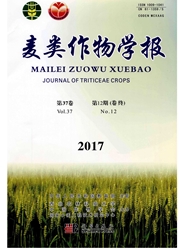

 中文摘要:
中文摘要:
为给小麦生产中土壤水分和施磷量的合理调控提供理论依据,通过防雨旱棚池栽方法,研究了在土壤水分胁迫(W1)和水分适宜(w2)条件下施磷量对小麦耗水特性及干物质积累的影响。结果表明,水、磷两因素对小麦的耗水特性和干物质积累均有重要影响。在W1奈件下,施磷150kg/ha的处理花后同化物对籽粒的贡献率高于其他两个施磷处理(75和225kg/ha);在W2条件下,随施磷量的增加,花后同化物的运转量及贡献率增加;W2下各处理花后同化物运转量及对籽粒的贡献率均大于W1。W1处理较W2处理的籽粒灌浆速率达到最大值的时间提前,而适宜施磷可提高最大灌浆速率。随土壤含水量的增加,麦田总耗水量上升,水分利用效率下降。W1条件下,耗水量和水分利用效率以施磷150kg/ha处理最高;W2条件下,各施磷处理间耗水量和水分利用效率差异不显著。在本试验务件下,虽然土壤含水量为田间持水量的75%与施磷150kg/ha的处理组合获得最高产量,但与土壤含水量为田间持水量的55%、施磷150kg/ha的处理组合的产量差异不显著,且后者水分利用效率最高。与其他处理差异显著,故综合考虑小麦的籽粒产量和水分利用效率,后者是较优水肥处理组合。
 英文摘要:
英文摘要:
In order to clar tion, a rain-proof pool eu ify the rational regulation of different water conditions and phosphorus applicalture experiment,including two water levels of Wl, moderate soil water content (75%) and W2, water stress(55%),and three fertilizing levels of P1(75 kg/ha), P2(150 kg/ha) and P3 (225 kg/ha) was conducted. The results showed that the two factors of water and phosphorus have important impact on dry matter accumulation and water consumption of wheat. The ratio of stored assimilation after anthesis contribution to grain in treatment P2 was higher than the other treatments under Wl. The transportation and contribution of stored assimilation to grain after anthesis in W2 were higher than those in Wl. Transportation and the ratio of contribution increased with the increase of phosphorus application under W2. Water consumption increased and WUE declined with the increase of soil water content. Water consumption and WUE of 150 kg/ha phosphorus treatment was the highest under W1, and it was not significant under W2. Considering both yield and WUE of wheat in the experiment, though W2P2 achieved the highest yield,compared with WlP2, there was no siganificant difference. WUE of WIP2 was the highest among those treatments. Therefore, the WlP2 treatment was the better combination of water and fertilizer.
 同期刊论文项目
同期刊论文项目
 同项目期刊论文
同项目期刊论文
 期刊信息
期刊信息
